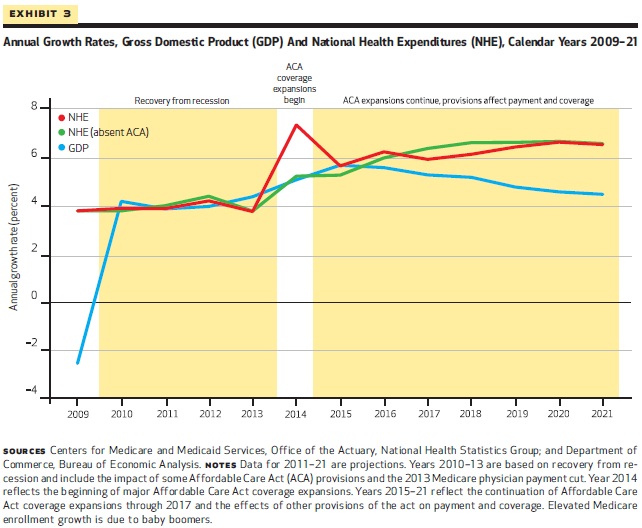Good News for Health Spending?
Actuaries at the Center for Medicare and Medicaid Services have published a new report detailing their projections for health care spending growth from 2011 to 2021. The growth rates they project may be good news for the economy and the budget as well if they pan out.
In recent years, health care spending growth has been much more modest, at least in part because of the recession. After averaging seven percent growth in the previous decade, growth has been around four percent in recent years and is projected to stay around there through 2013. A big debate in the health policy world has been taking place over whether this slowdown represents solely the effects of the recession or structural changes in the health care system that will permanently slow growth.
According to CMS's projection, it's somewhere in between. As the economy recovers and the Affordable Care Act's major coverage expansions kick in, spending growth will jump to about seven percent but settle in around six percent for the rest of the projection period. Overall, from 2011-2021, health care spending grows on average at 5.7 percent annually, only about 0.9 percentage points faster than GDP (note that the Independent Payment Advisory Board's goal is to limit Medicare spending growth per beneficiary to GDP plus one percent).
The Affordable Care Act's effect on overall health spending is actually somewhat small on net, according to CMS. The report very helpfully shows their projections for national health expenditures with and without the ACA. There is a large bump up in growth in 2014 when the coverage expansions kick in, but it quickly converges to non-ACA growth rates and in fact slows growth for some years later in the decade. Cumulatively, the ACA will add $478 billion to health spending through 2021 (for context, total health spending in 2021 will be $4.8 trillion).
Of course, it's no time to break out the champagne even if these projections do pan out. Notice that excess cost growth--the amount by which health spending growth exceeds GDP growth--gets larger later out in the decade. In addition, these calculations take into account the 27 percent Medicare physician payment cut and the sequester's hit on Medicare starting in 2013, both of which are unlikely to occur (especially the former).
Still, the amount of excess cost growth is very important to the budget, so this projection is a bit of good news. CBO's Long Term Budget Outlook shows that having no excess cost growth after 2022 would lower their current law projections of federal health care spending by two percentage points of GDP in 2037. Although this would by no means put our debt on a sustainable path by itself--assuming policymakers continue spending and taxing like they have--it would still go a long way. As we said last week, policymakers should continue to be vigilant on health care cost growth and emphasize policies that can reduce it.


